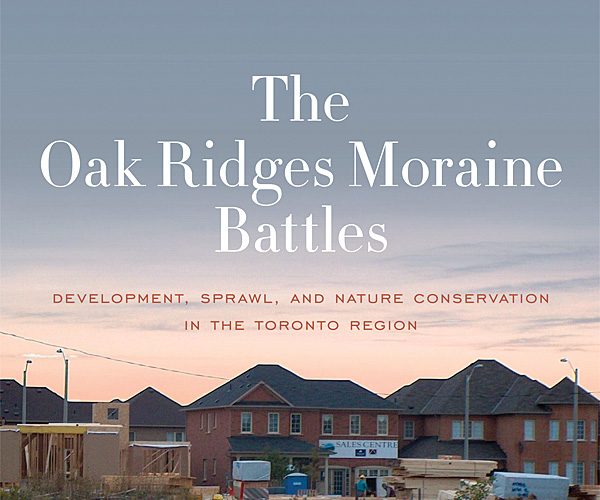One of North America’s largest conservation areas sits on the suburban fringe of Canada’s largest metropolis, home to more than five million people. The Oak Ridges Moraine spans 190,000 hectares of forests, wetlands, lakes and prairies north of the Greater Toronto Area (GTA), but it has been conceptualized as a single, linked entity for only a little more than 30 years.
One of North America’s largest conservation areas sits on the suburban fringe of Canada’s largest metropolis, home to more than five million people. The Oak Ridges Moraine spans 190,000 hectares of forests, wetlands, lakes and prairies north of the Greater Toronto Area (GTA), but it has been conceptualized as a single, linked entity for only a little more than 30 years.
This rich empirical and conceptual study explains how the idea was created and how the area came to be managed as a conservation zone under the auspices of the Oak Ridges Moraine Conservation Plan and Act of 2001. The book’s authors, a trio of veteran social movement and political ecology scholars from York University, detail how this hard-won – if compromised – victory was achieved.
The moraine’s hydrogeology is complex. Its wetlands and aquifers feed into more than a dozen watersheds, and conserving the Oak Ridges Moraine was predicated on framing the area as a single, linked hydrological and geological system. Scientific support for the notion of the moraine as a bioregion helped to validate its conservation value, and aided the planning bodies and political institutions that developed the legislation.
Activists argued that because the moraine is a unified system, it cannot be protected in sections. The authors repeatedly critique the spatial understanding of nature that emerged in the Oak Ridges Moraine Conservation Plan and Act, which bounds and cleanly separates some parts of the moraine for human uses while excluding these uses in other areas. In reality, the fragmented land uses that make up the moraine demonstrate exactly how ineffective the legislation has been at preventing new construction. For example, in Richmond Hill – the site of some of the fiercest protests – the use of “grandfathering” clauses in the provincial land-use review system has added enormous tract-housing developments in areas slated for conservation.
Using a genteel country living ideal that they call “rurality,” the authors also show how the class and racial character of the resistance movement included and excluded certain moraine uses and users. While the coalition included local, regional and international organizations, the struggle was led primarily by white, well-off suburban and exurban landowners. As our cities expand, similar populations will be at the center of struggles over sprawl, and ultimately the shape of our shared spaces will hinge on their power. In the case of the Oak Ridges Moraine, white middle-class activism was able to influence how the state understands and categorizes nature. In contrast, attempts by largely working-class and poor people of colour to mobilize and highlight public housing challenges in Toronto’s inner suburbs have been unable to make the same level of impact.
The book’s insights about the lasting implications of the Oak Ridges Moraine clashes are especially noteworthy. Progressive industry branding, notably related to “smart growth” practices, has become more much common. Some developers have enlisted prominent former moraine activists, such as Toronto City Councillor Glenn De Baeremaeker, to be project boosters. The moraine has also been used to enhance the GTA’s competitive image, which brands the city as having abundant natural space in its backyard – even though many of the moraine’s battlegrounds have now been developed into exclusive (if not outright private) country clubs, luxury retreats or golf courses.
The Oak Ridges Moraine Battles could have benefited from an expanded look at the power relations that allow different groups to access the state in its widest sense. Nevertheless, the book is a rigorously detailed and conceptually nimble work that asks challenging questions about how to think about nature in order to defend it.
The Oak Ridges Moraine Battles: Development, Sprawl, and Nature Conservation in the Toronto Region, L. Anders Sandberg, Gerda R. Wekerle, and Liette Gilbert, Toronto: University of Toronto Press, 2013, 336 pages
This review originally appeared in Night, Issue 39.5. Subscribe now to get more reviews in your mailbox!
Reviewer Information
Nate Prier is a PhD candidate in Geography at York University. He researches and organizes with decolonization and migrant justice movements in Europe and on Turtle Island.













